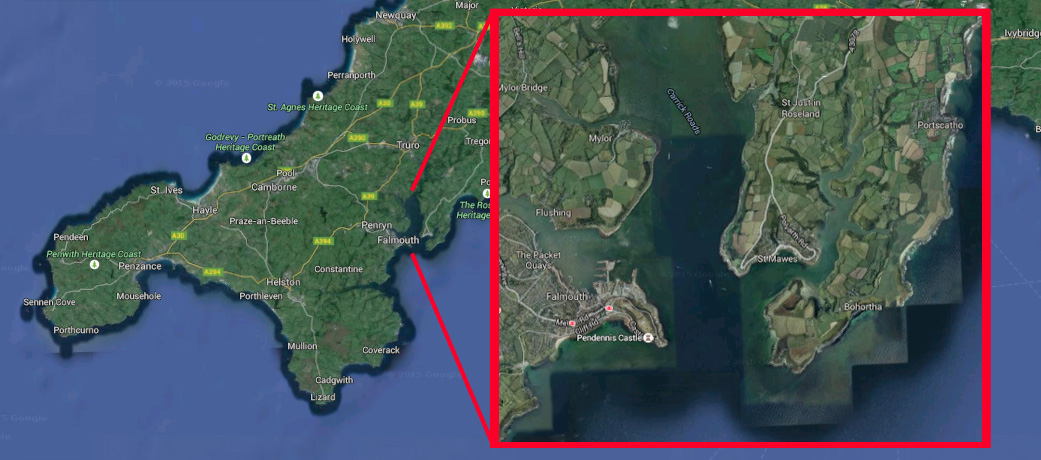
The Fal Estuary located on the south coast of Cornwall in the UK. It is a drowned river valley or ria which is composed of many tidal creeks which flow into an area of deep water known as Carrick Roads (Somerfield, Gee & Warwick, 1994).
The area of Fal and Helford is designated as a Special Area of Conservation, covering
6387.8 hectares (JNCC, No Date A). This gives the area strict protection under the
EU Habitats Directive, as it is a high quality conservation site The Annex I habitats
which are the main reasons for its designation are sublittoral sandbanks, mudflats,
large shallow bays and atlantic saltmarsh meadow. Annex I habitats are those considered
most in need of conservation around Europe (JNCC, No DateB). Both maerl, Phymatolithon
calcerum and Lithoamnium coralloides and eelgrass, Zostera marina, are of particular
importance as they act as nursery grounds for fish and shellfish which are commercially
valuable (Newton & Hall-
In 1992, contaminated water from the local Wheal Jane mine burst free, causing massive
heavy metal pollution. This has been widely studied since the incident, and a government
funded treatment plant put in place to prevent further contamination (BBC, 2012).
Tributyltin is another common pollutant found in the Fal Estuary (Hagger et. al.
2009), as it can be used as an antifouling agent. The UK government has controlled
the sale of tributyltin pains for use on small boats since 1985, as the agent can
leach off the hulls of boats. The most well-
References
Deeble, M., Stone, V., 1985. A port that could threaten marine life in England’s
Fal Estuary. Oryx. 19:02 pp. 74-
Somerfield, P. J., Gee, J. M., Warwick, R.M., 1994. Soft sediment meiofaunal community
structure in relation to long term heavy metal gradient. Marine Ecology Progress
Series. 105. pp. 79-
JNCC, No Date A. Fal and Helford. [online] Available at: <jncc.defra.gov.uk/protectedsites/sacselection/sac.asp?EUcode=UK0013112> [Accessed 27/06/2015]
JNCC, No Date B. Special Areas of Conservation. [online] Available at: <jncc.defra.gov.uk/page-
BBC, 2012. Wheal Jane unused mine contaminated water levels down. [online] Available
at: <www.bbc.co.uk/news/uk-
Newton, J., Hall-
Heck, K. L., et. al. 1995. Composition, abundance, biomass and production of macrofauna
in a New England estuary: Comparison among eelgrass meadows and other nursery habitats.
Estuaries. 18:2. pp. 379-
Hagger, J. A., et. al. 2009. Application of biomarkers to assess the condition of
European Marine Sites. Environmental Pollution. 157:7. pp. 2003-
Santillo, D., Johnston, P., Langston W. J., 2001. Tributlytin (TBT) antifoulants:
a tale of ships, snail and imposex. European Environment Agency Environmental Issue
Report Number 22. pp. 135-
The Team
Group 4 consists of 8 students from the University of Southampton and 2 exchange students from the University of Sao Paulo in Brazil. We are a mixture of Marine Biology and Oceanography undergraduates, this brings a variety of different skills and approaches to our tasks.
Samuel Chamberlain -
Ollie Mclaren-
Marc Morris -
Beth Sims -
Alice Gibbin -
Denise Prates -
Guillemette Rident -
Lu Wang -
Sarah Rose Alewijnse -
Sérgio Giovannino -
Denise Prates
Disclaimer-
Falmouth 2015 Group


| Aims |
| Methods |
| Results and Discussion |
| References |
| Benthic Habitat Map |
| Cameras |
| Aims |
| Methods |
| Results |
| Discussion |
| Aims |
| Methods |
| Results |
| Discussion |
| References |
| Aims |
| Methods |
| Results and Discussion |
| References |
| Temperature and Density |
| Nutrients and Oxygen |
| Chlorophyll and Fluorescence |
| Plankton |
| ADCP |